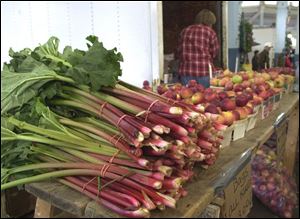
Keep those rhubarb plants growing strong
6/16/2004Pucker up, the rhubarb is ready! A well-established rhubarb patch can remain productive for more than 50 years.
The big wavy leaves of Rheum rhabarbarum L. make a great addition to a sunny perennial landscape. Keep the leaves off the dinner table, though, because they contain oxalic acid and can be toxic.
Rhubarb is grown for its sour stalk. In most varieties, the stalk turns reddish-green when it is ready to harvest. Rhubarb's harvest time coincides with strawberries in May and June.
The sturdy vegetable has been around for more than 2,000 years. Like asparagus, rhubarb grows from a crown planted just below the soil surface in early spring. If you missed getting a start a few months ago, wait until fall and plant them when the rhubarb is dormant.
Crowns should be planted about four feet apart. They like a lot of gourmet compost and a 5-10-10 fertilizer in the spring and midsummer. A sprinkle of blood and bone meal around the crown won't hurt. Keep them watered during dry spells. Their big leaves and succulent stems need lots of moisture.
When harvesting rhubarb, hold the stalk near the ground and gently tug it off the crown. Cutting the stem will cause it to bleed, and that sweet liquid will invite bugs and cause the crown to rot.

Rhubarb's stalks are edible, but the large green leaves should not be eaten.
Give rhubarb plants a chance to get established by not harvesting the first year and by pulling only a few stalks the second year. By the third year, the crown is mature and can be harvested. Never pull all of a plant's stalks. Take about one-third to one-half of the stalks at a time to allow the crown to keep feeding itself.
If a plant starts to produce skinny stalks, stop harvesting it. It needs to catch up to your big appetite.
After a hot, dry spell, rhubarb sends up a flower or two. The white blossoms are pretty, but I like the stalks more. If you use a lot of rhubarb, cut the flower stalks as soon as they sprout. That will funnel the plant's energy back into producing more stalks, rather than flowers.
If a rhubarb patch is more than 10 years old, consider dividing the crowns. In early spring, dig up the crowns and cut them with a hatchet or the end of a sharp spade into fist-size pieces. Cut off any signs of disease or rot.
After the harvest, let the plant grow and build up a stronger crown until it is killed off by a hard fall frost.
If you don't cook it up right away, freshly cut rhubarb can be stored in perforated vegetable bags in the refrigerator up to four weeks. You can also toss it in your freezer. You may need to adjust your recipe when using frozen rhubarb because it makes it much juicier when thawed.